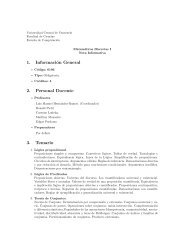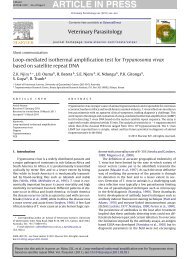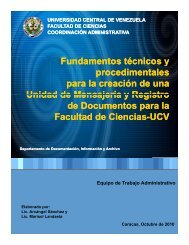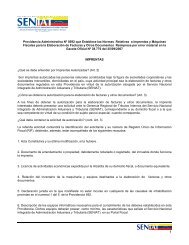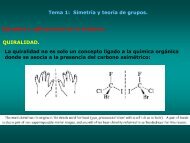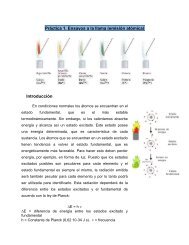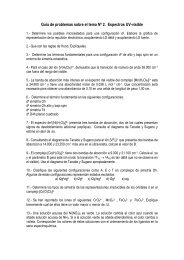Collecting and Preserving
Collecting and Preserving
Collecting and Preserving
- No tags were found...
You also want an ePaper? Increase the reach of your titles
YUMPU automatically turns print PDFs into web optimized ePapers that Google loves.
grooves as deep <strong>and</strong> as wide as the wire are cut from eachhole to the end of the dowel to receive the straight part ofthe wire (fig. 2, D).(5) Tape or wire to lash the ends of the rims tightlyinto the grooves in the end of the h<strong>and</strong>le. This may beelectrician’s plastic tape or fiber strapping tape commonlyused for packaging. If wire is used, the ends should bebound with tape to secure them <strong>and</strong> to keep them fromsnagging. A close-fitting metal sleeve (ferrule) may beslipped over the rim ends <strong>and</strong> held in place with a smallroundheaded screw instead of tape or wire lashing.Techniques <strong>and</strong> Toolsthrough the netting when the butterfly’s wings are closed.Experience will teach you how much pressure to exert;obviously, pinching small specimens of any kind is notrecommended. When numerous specimens are in the netafter prolonged sweeping, it may be desirable to put theentire tip of the bag into a large killing jar for a fewminutes to stun the insects. They may then be removed <strong>and</strong>desired specimens placed separately into a killing jar, orthe entire mass may be dumped into a killing jar for latersorting. These methods of mass collecting are especiallyadapted to obtaining small insects not readily recognizableuntil the catch is sorted under a microscope.After the net has been placed on the rim, the ends ofthe b<strong>and</strong> should be sewn together <strong>and</strong> the rim endsfastened to the h<strong>and</strong>le. The other end of the h<strong>and</strong>le shouldbe filed to remove sharp edges. The net is then ready foruse (fig. 2, E).Efficient use of a net is gained only with experience.Collection of specimens in flight calls for the basicstroke—swing the net rapidly to capture the specimen,then follow through to force the insect into the verybottom of the bag. Twist the wrist as you follow through sothe bottom of the bag hangs over the rim; this will entrapthe specimen. If the insect alights on the ground or othersurface, it may be easier to use a downward stroke, quicklyswinging down on top of the insect. With the rim of the netin contact with the ground to prevent the specimen fromescaping, hold the tip of the bag up with one h<strong>and</strong>. Mostinsects will fly or crawl upward into the tip of the bag,which can then be flipped over the rim to entrap thespecimen.Sweeping the net through vegetation, along the s<strong>and</strong><strong>and</strong> seaweed on beaches, or up <strong>and</strong> down tree trunks willcatch many kinds of insects <strong>and</strong> mites. The aerial net maybe used in this way, but the more durable sweeping net isrecommended for such rough usage. After sweeping withthe net, a strong swing will bring anything in the bag to thebottom, <strong>and</strong> then by immediately grasping the middle ofthe net with the free h<strong>and</strong>, the catch will be confined to asmall part of the bag. Only the most rugged sweeping netmay be used through thistles or brambles. Even somekinds of grasses, such as sawgrass, can quickly ruin a net.Burs <strong>and</strong> sticky seeds are also a serious problem.The catch may be transferred from the bag to akilling jar in one of several ways. Single specimens aretransferred most easily by lightly holding them in a fold ofthe net with one h<strong>and</strong> while inserting the open killing jarinto the net with the other. While the jar is still in the net,cover the opening until the specimen is stupefied; otherwise,it may escape before the jar can be removed from thenet <strong>and</strong> closed. To prevent a butterfly from damaging itswings by fluttering in the net, squeeze the thorax gentlyRemoval of stinging insects from a net may be aproblem. They will often crawl toward the rim of the bag<strong>and</strong> may be made to enter a killing jar held at the pointwhere they crawl over the rim. However, many insects willfly as soon as they reach the rim, <strong>and</strong> a desired specimenmay be lost. A useful method is to trap the insect in a foldof the net, carefully keeping a sufficient amount of nettingbetween fingers <strong>and</strong> insect to avoid being stung. This foldof the net can then be inserted into the killing jar to stunthe insect. After a few moments, it should be safe toremove the insect from the net <strong>and</strong> transfer it to a killingjar. If the stunned insect clings to the net <strong>and</strong> does not fallreadily into the jar, use forceps or pry the insect loose withthe jar lid or a small stick—not with your fingers.Aerial nets made of dacron or nylon may be used tosweep insects from water if an aquatic net is not at h<strong>and</strong>.The netting will dry quickly if swept strongly through theair a few times; however, it should not be used again untilthoroughly dry, or other specimens, especially butterflies,may be ruined. A number of special modifications arenecessary to adapt a net for aquatic collecting.For specialized collecting, nets can be attached to theends of beams that are rotated about their midlength by amotor drive. Nets also can be adapted to be towed by ormounted on vehicles (fig. 3) (Peck <strong>and</strong> Cook, 1992).References: Dresner 1970; Johnson 1950; Rogers &Smith 1977; Rudd & Jensen 1977; Takeda et al. 1962;Williams & Miine 1935; vehicle-mounted net: Alm<strong>and</strong> etal. 1974; Barnard 1979; Grigarick 1959; Harwood 1961;Hill 1971; Holzapfel et al. 1978; Kronblad & Lundberg1978; L<strong>and</strong>in 1976; McNutt 1976; Noyes, 1982; Rudd &Jensen 1977; Torre-Bueno 1937; Traver 1940.1.3 Killing Jars or BottlesEffective collecting of insects <strong>and</strong> related groupsusually requires that the specimens be killed so that theymay be properly mounted <strong>and</strong> studied. The most widely7



